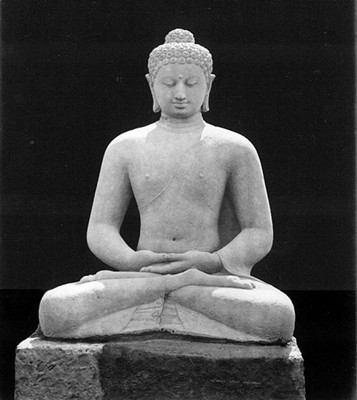He's seated cross-legged in the lotus position, a pose used for meditation and, as here, for teaching.
他的莲花坐姿是佛教中冥想与说法时的姿势。
But this statue-and the thousands made later that look so like it-has a purpose.Tibetan Thupten Jinpa, a former monk and interpreter to the Dalai Lama, explains how you use an image like this one as a help on your journey towards enlightenment:
这尊佛像与后来出现的成千上万的类似佛像都有着同一个目的。曾做过僧人的图登金巴向我们解释佛像如何助人开悟:
"What the religious practitioners do is to bring the image of the Buddha-by first looking at the image, and then bringing that image of the Buddha within oneself-in a sort of a mental image.And then reflect upon the qualities of the Buddha-Buddha's body, speech and mind. The image of the Buddha plays a role of recalling in the mind of the devotee, the historical teacher, the Buddha, and his experience of awakening, and also the key events in his life. There are different images, forms of the Buddha, that actually kind of symbolise those events. For example, there is a very famous posture of the Buddha, which is seated but with his hand in a gesture of preaching. Technically, this hand gesture is referred to as the gesture of turning the wheel of dharma, Dharmachakra.
修行者凝视佛像,佛的形象随之进入他们的心灵。之后他们思考佛的身、语、意。佛像能令信徒想起佛陀,回忆起他的奉献、开悟以及重要事迹。不同形式的佛像实际上就代表了不同的事迹。比如,佛陀有一个很著名的姿势:结跏趺坐,手作说法印。其实严格来说, 这应该叫转法轮印,意为转动佛法之轮。
And this is the hand gesture of our seated Buddha. The Dharmachakra, or Wheel of Law, is a symbol that represents the path to enlightenment, and it's one of the oldest known Buddhist symbols found in Indian art.
这正是本文中坐佛的手势。法轮象征了通往开悟的道路,是印度艺术中已知最古老的佛教象征。













